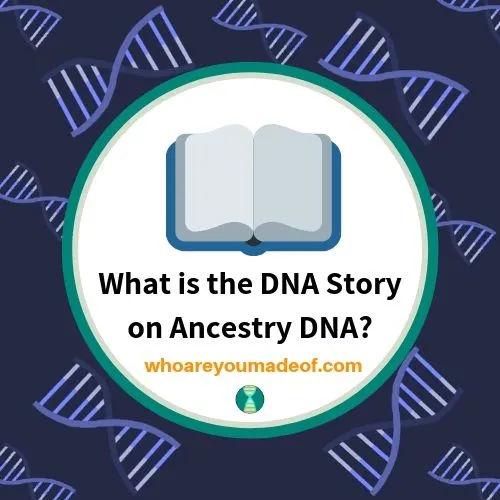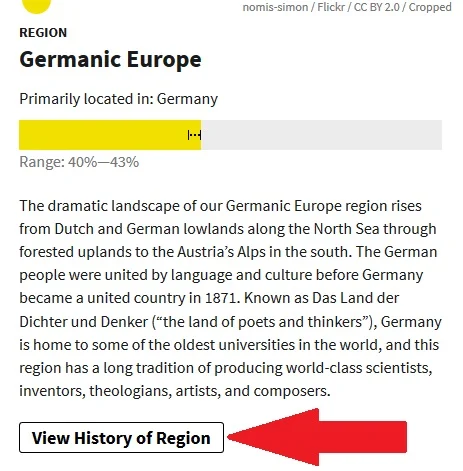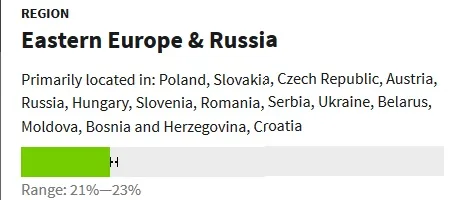Do you want to learn more about your DNA Story on Ancestry DNA? In this post, you will learn how each element of your DNA Story works together to help you learn about your family's origins.
This article will answer the following questions:
- What in a DNA Story on Ancestry?
- How to you read an Ancestry DNA Story?
- Will your DNA Story match your family tree?
- Will close relatives have the same DNA Story?

Even if you have already seen your DNA Story in your Ancestry DNA results, there is a good chance that there are a few surprise elements that you haven't explored. This article is sure to show you something new!
What is an Ancestry DNA Story?
Your DNA Story on Ancestry is an interactive story about your family's likely origins based on your unique DNA. Elements of the story include your ethnicity estimate, migrations your ancestors were part of, and historical details about the regions on your ethnicity estimate.
There are several aspects of your DNA Story that might not seem apparent at first glance:
- Ethnicity estimate percentages
- Range of percentages of DNA for each region
- Additional communities in your ethnicity estimate
- History of your DNA regions
- DNA Story timeline
- Featured DNA matches
- Regional stories!
Since the DNA Story isn't really like a traditional story in a book, it's a good idea to learn a little bit about how best to navigate through the story in order to get the most from your DNA results.
I will discuss in more detail all of the individual elements that I listed above in the sections below.
How do you read an Ancestry DNA story?
Once you have some time to explore your Ancestry DNA Story, the first thing that you should do is navigate from your Ancestry DNA dashboard (or main Ancestry dashboard) by clicking on the "DNA" tab on the top of your screen.
A drop-down menu will appear, and you should select "DNA Story" from the menu.
From your main DNA Story page, you can begin to explore your unique story. No two DNA Stories are exactly the same!
The sub-sections below will walk you through what you can learn in the different elements of your DNA Story.
Ethnicity estimate on your Ancestry DNA Story
The most noticeable part of your Ancestry DNA Story will be your ethnicity estimate. This is the list of percentages, colored dots, and a corresponding map that explains which regions of the world most closely match your DNA.
From your ethnicity estimate, you can learn where your most recent ancestors most likely lived, or from where most of their recent ancestors were from.
We don't inherit DNA from all of our ancestors (more on this below), but our ethnicity estimates tell us a lot about the DNA that we did inherit.
History of your DNA regions from your ethnicity estimate
When I first saw my updates ethnicity estimate results (yes, Ancestry occasionally updates our results for FREE based on the latest science), I saw Norway on my list. If I am honest, I knew very little about Norway and how I might have inherited DNA from the region.
Ancestry includes informative, brief essays about each region that can help us learn a little bit about the history of our DNA regions. Knowing the history can help us figure out how these DNA regions may have ended up in our family tree.
To access these essays on DNA regions, simply click on the DNA region that you'd like to learn more about from your ethnicity estimate. Then, click " View History of Region" (as shown in the image below).

Range of percentages on each DNA region
A commonly overlooked aspect of the ethnicity estimate on Ancestry DNA is the range of percentages that go along with each ethnicity region.
How do they get the range of percentages? They run randomly selected pieces of your DNA through a test 1,000 times, and the results of those 1,000 times are your range.
In the image below, you can see that I have 21% Eastern Europe and Russia DNA in my ethnicity estimate. The range is 21-23%, which means that each time they ran my DNA through the test, the results were fairly consistent.

You can check your range for all of the regions on your report. Sometimes, you'll notice that your range could be as low as 0%. This means that for some of the times that they tested your DNA, this region didn't show up.
Additional Communities in your DNA Story and Ethnicity Estimate
If Ancestry DNA is able to detect in your DNA that you "belong" to a particular community of migrants, settlers in a particular region, or long-time residents of a particular area, this will be reported in the "additional communities" section.
The cool thing about this feature is that if you click on one of the communities, you can see featured DNA matches that also share this community with you. You can also learn how many Ancestry DNA members also found this community in their DNA.
DNA Story timeline on Ancestry DNA
Have you noticed your DNA Timeline on your DNA Story? Directly from your ethnicity estimate or DNA Story home screen, you might notice a long timeline that extends across the entirety of the page.
To explore the information in your DNA Story Timeline, just pick a time period.
For example, I clicked on 1750 on my own DNA Timeline, and saw Regional Stories based on my DNA. My Regional Stories for 1750 were:
- A Time of Turmoil
- Turmoil in the Colonies
If I click on one of the Regional Stories, I can see a list of people from my family tree who were born during that time period. This is another reason to build a family tree!
The DNA Timeline on your Ancestry DNA Story is a powerful feature. There is a lot of to learn, and so I have decided to write an entire post dedicated to it (coming in a few days - link to be posted here).
Will your DNA Story match your family tree?
Our DNA Story will not usually precisely match our family tree. The more you know about your family's ancestry, the stranger the DNA Story might seem to you.
In fact, one of the most common e-mails that I get from my readers are pertaining to their ethnicity estimates. People get really upset when they don't see an ethnicity region from a particular ancestor in their results.
There is an explanation for this, and it doesn't mean that your DNA Story isn't accurate.
The reason that our DNA Story doesn't match our family tree in many cases is because we don't actually inherit DNA from all of our ancestors. We share DNA with all of our recent ancestors and only inherited DNA from some of our more distant ancestors.
A child only inherits 50% of each of their parent's DNA, meaning that there is 50% of each of their parent's DNA that they didn't inherit. This also means that "DNA information" is lost with the arrival of each new generation.
Our DNA Story can only reveal information about the DNA that we did inherit from our ancestors and can't tell us anything about the DNA that got left behind in previous generations.
This is one reason why DNA is best used in combination with family tree research. DNA can serve as an effective guide to point us in the right direction, but there is a limit to what we can learn about our ancestry through DNA.
Will close relatives have the same DNA Story on Ancestry?
As you have already learned (in the previous part of this post), a child inherits only 50% of their mother's DNA and 50% of their father's DNA. The exact 50% that they inherit is "randomly" selected, and two siblings, even full siblings, will never inherit a selected 50% that identically matches their siblings.
The only exception to this rule is in identical twins, since their DNA is identical. Full siblings can share as little as about 33% of their DNA with each other.
As you can now probably guess, even if your parents will have a whopping 50% of their DNA that doesn't match theirs. There may be entire ethnicity regions and communities that would show up in your parents' DNA that won't show up in yours, simply because you didn't inherit all of their DNA.
The same is true for your aunts and uncles, and even your grandparents. Each one of these relatives has DNA that doesn't match yours (or your parents).
This is the reason why DNA Stories of close relatives might have different regions, different percentages for regions, different migrations and communities, and even different distant DNA matches.
Conclusion
I hope that this post has helped you understand more about your Ancestry DNA Story, whether your story should match your tree, and how to navigate through your story.
If you have any questions about something that you read in this post, or if you would like to share something that you learned from your own DNA Story on Ancestry, I would love for you to join us in the discussion below.
Thanks for being here today!

